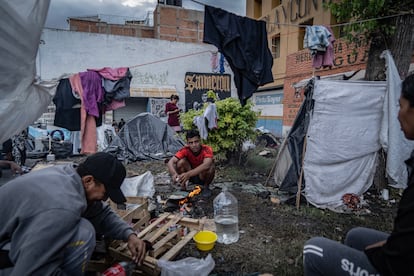Mexico, a wall for migrants trying to reach the United States
The record of arrests in 2023 and the internal deportation strategy used by authorities evidence that the Mexican government is putting obstacles in the way of people moving towards the northern border


Ermel Corona, a citizen of Ecuador, was arrested in Veracruz and returned to an immigration detention center in Tabasco. A family from Honduras — Gerson Torres, his wife and four children — were taken off a bus twice and lost what they paid for the tickets. In the Mexican capital, a non-profit group confirmed that almost a dozen migrants spent more than 36 hours, the maximum time they can be detained, in an immigration station. In Nuevo León, an organization of lawyers stopped the transfer of people from the northern to the southern border, the most common tactic to wear out the migrants. In 2023, Mexico detained 782,176 people in an irregular situation — the highest figure since records began and almost double that of the previous year — and became the wall against those eager to reach the United States.
Gerson Torres, his wife and their four children, who are between five and 12 years old, were detained not once, but twice. They left Honduras three months ago and spent about two weeks in Tapachula, a city on Mexico’s southernmost border, near Guatemala. After leaving there, the worst came in the southern state of Oaxaca. “They detained us first in San Pedro Tapanatepec. Then we took another bus in Oaxaca and half an hour after leaving they took us off again,” he explains. In the detention centers, which the National Migration Institute (INM) calls immigration stations, they were only there for an hour, they were “treated well” and they were released. But of course, they lost the 4,600 pesos they had paid for the tickets and had to walk to the capital. “The children got sick, they are hungry and have blisters on their feet,” explains the father.
Hondurans represented 15% of migrant detentions in Mexico in 2023, putting them at the top of the list. The reasons to leave the country are many. “We lived in the capital, Tegucigalpa. With so much crime everything collapsed, the basic basket of goods went up in price and in any job you earn just $5 or $7 a day for the whole family,” Torres recalls. The family made a living selling fish, vegetables and other products at a food store, similar to the Oxxo store under which they now sleep in a tent in Mexico City. These days they sell popsicles on the street to finance their trip north while they fill out the CBP One, the immigration form that is completed through a cell phone application and that the United States devised so that migrants could wait for their asylum request in Mexico.
For Torres and his family and hundreds of thousands of more people, Mexico has become a wall that they run into in their bid to reach the United States. This year, more than 500,000 people crossed the Darién Gap, the jungle between Colombia and Panama that’s a deadly trap for migrants. That is double the figure for 2022, according to Human Rights Watch (HRW). This increase was noted on the southern border of the United States, where a record of arrests was also set in 2023, with 2,475,669 million people detained. It was an increase of 4% compared to the previous year. In Mexico, the number of migrant arrests increased by 44% from 2022 to 2023, according to INM data.
The surge in arrests contrasts with the number of deportations. While in 2022 there were 120,000, in 2023 they fell to 50,000. Where are all the detained people going then? Most experts agree that Mexico is carrying out internal “deportations” from the northern border to the southern, a tactic that wears down migrants who have often spent all their savings to reach the border with the United States.
One such case was defended by the Alaide Foppa Refugee Legal Clinic in November 2023. The organization filed an appeal on behalf of 14 migrants who were detained between three and five days at the Guadalupe immigration station, in Nuevo León, near U.S. territory. A resolution of the Supreme Court of Justice from March 2023 says that migrants can only spend a maximum of 36 hours in these detention centers. However, in Nuevo León, authorities never initiated proceedings against these people.
What the authorities wanted was to take them to the south of Mexico again, to another detention center, where the 36 hours would officially start to be counted. “The Refugee Clinic has confirmed that migrants are detained in the north of the country with the aim of being transferred to the center or the south, as part of the immigration containment policies,” read the lawyers’ statement. Salvador Guerrero, director of the Legal Clinic for Refugees at the Universidad Iberoamericana, describes these internal movements as “a kind of roulette.” “The intention is to tire them out so that they do not go up to the border with the United States,” the lawyer denounces.
Something similar happened to Ermel Coronel. The 48-year-old Ecuadorian has migrated twice, fed up with extortion and the wave of violence ravaging his country. Once in early 2023, across the Darién; and again last January on a flight from Quito to El Salvador, because he had to return to his country to collect documentation. From El Salvador, he traveled to Guatemala and re-entered Mexico. “Along the way in Mexico, they ripped up the same document that immigration gives you with permission to stay for 45 days,” he explains.

In Veracruz, while Coronel was traveling to Mexico City by bus, he was stopped at 9 p.m. “We were there for 12 hours. Then they took us to a detention center in Villahermosa [Tabasco]. There they fed us, they signed a paper to release us and we left,” he recalls. Even though he was not mistreated, he had to spend part of his savings again to buy another bus ticket. While passing through Acayucan, again in Veracruz, an immigration agent asked him for his papers again. He pretended to be looking for them and the officer noticed a Guatemalan two seats behind him. He was the one who ended up under arrest.
This internal “deportation” strategy is another one of the reasons that add to the list of migrant detentions in Mexico in 2023. “Since they are taking people south again, they get detained again,” explains Gretchen Kuhner of the Institute for Women in Migration (IMUMI), who has been studying immigration patterns in the country for 25 years.
She and other IMUMI colleagues entered an immigration station in Mexico City on February 6. There they observed the good conditions in which 11 of the migrants with whom they were able to speak, mostly Guatemalans, were treated that day. One of them asked to tell her story privately. She said through tears that she had been in the immigration station for 13 days and just wanted to return to Guatemala so she could see her little daughter. Of the 11 women they visited, eight had spent more than 36 hours at the immigration station.
In addition, migrants do not have access to legal defense in these centers, which by law they should have. “Lawyers often do not have contact with people. The public defender is not there, because they cannot attend to the thousands of people who come in on a daily basis. The migrants sign that they agree with that and they are released,” explains legal advisor Salvador Guerrero. EL PAÍS tried unsuccessfully to contact the INM to find out what caused the high number of arrests in 2023 and its response to these accusations from NGOs and migrants.

The detention policy contrasts with the initial rhetoric of the president of Mexico, Andrés Manuel López Obrador, who after beginning his term in December 2018 established a looser policy to guarantee the basic rights and conditions of migrants. Things changed in June 2019, after the then president of the United States, Donald Trump, threatened to impose tariffs on Mexico if it did not stop the flow of migrants. The immigration issue was “militarized and securitized at the request of the United States,” explains Eunice Rendón, coordinator of the consultancy Agenda Migrante.
Mexican protection of the borders has continued during the Biden administration. The year 2023 has stood out for the pressure that Republicans are exerting with their anti-immigrant rhetoric with a view to the presidential election in November. “There have been some efforts [by Mexico] to have comprehensive policies, such as the 2020 law so that children cannot be in immigration stations. Although Title 42 and the Migrant Protection Protocol program [two anti-migrant programs that the United States applied to ensure that migrants remained in Mexico] were established by Trump, they were used much more in the Biden era and in agreement with the Mexican government,” explains Rendón.
While dozens of bilateral meetings continue to take place every year between the governments of the United States and Mexico to negotiate immigration issues, hundreds of people are sleeping on the streets of Tapachula, on the border between Guatemala and the Mexican state of Chiapas, waiting to regularize their situation. Others on the northern border risk their lives crossing the Rio Grande to try to reach the United States. Meanwhile, Gerson and his family are living in a tent, like hundreds of Haitian migrants, in the Plaza Giordano Bruno in Mexico City. Ermel is waiting to regularize his situation in Mexican territory so he can get a job. Torres and Coronel say they want to return to their countries of origin one day. “I have a daughter in Ecuador who is studying medicine, I would like to bring her over. But when everything is done, I want to return,” says Coronel.
Sign up for our weekly newsletter to get more English-language news coverage from EL PAÍS USA Edition
Tu suscripción se está usando en otro dispositivo
¿Quieres añadir otro usuario a tu suscripción?
Si continúas leyendo en este dispositivo, no se podrá leer en el otro.
FlechaTu suscripción se está usando en otro dispositivo y solo puedes acceder a EL PAÍS desde un dispositivo a la vez.
Si quieres compartir tu cuenta, cambia tu suscripción a la modalidad Premium, así podrás añadir otro usuario. Cada uno accederá con su propia cuenta de email, lo que os permitirá personalizar vuestra experiencia en EL PAÍS.
¿Tienes una suscripción de empresa? Accede aquí para contratar más cuentas.
En el caso de no saber quién está usando tu cuenta, te recomendamos cambiar tu contraseña aquí.
Si decides continuar compartiendo tu cuenta, este mensaje se mostrará en tu dispositivo y en el de la otra persona que está usando tu cuenta de forma indefinida, afectando a tu experiencia de lectura. Puedes consultar aquí los términos y condiciones de la suscripción digital.
More information
Archived In
Últimas noticias
Maduro pleads not guilty before the federal court in New York: ‘I am still the president of Venezuela’
A new test can detect Alzheimer’s from a finger prick
UN team enters Sudanese city of El Fasher after paramilitary massacre: ‘It’s like a ghost town’
A recipe for resistance: Indigenous peoples politicize their struggles from the kitchen
Most viewed
- Gilles Lipovetsky: ‘If you want to live better and fall in love, take Prozac, don’t look to philosophy’
- Alain Aspect, Nobel laureate in physics: ‘Einstein was so smart that he would have had to recognize quantum entanglement’
- Alvin Hellerstein, a 92-year-old judge appointed by Bill Clinton, to preside over Maduro’s trial in New York
- Why oil has been at the center of Venezuela-US conflicts for decades
- Maduro’s downfall puts China’s relationship with Venezuela to the test









































